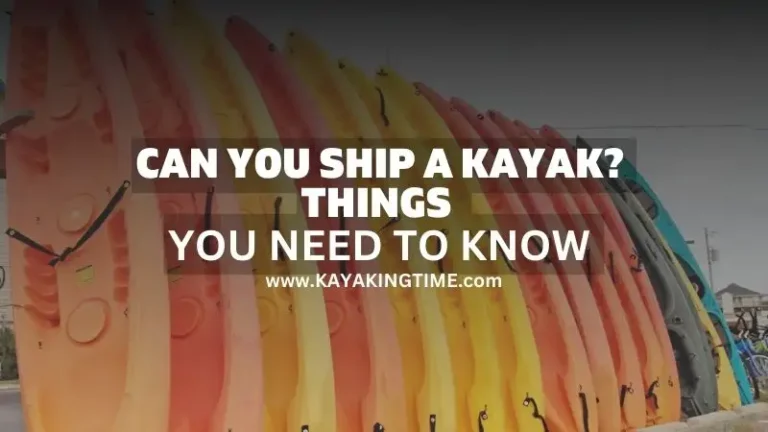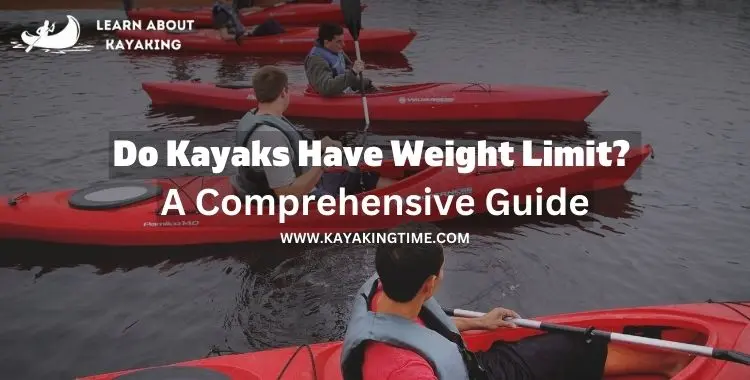Mastering the Art of Using a Kayak Cart: From C-Tug and Scupper to DIY Trolleys and Affordable Options
Do you enjoy kayaking but hate the back pain and overall work associated with loading and unloading your kayak? If this sounds familiar, the kayak cart may be just what you want!
But how to use a kayak card! and is it worth buying? Don’t worry, I’ll provide you with great instructions on how to use a kayak cart and how it will make your life easier, making your kayaking adventures more convenient and enjoyable.
What is a kayak cart?

In simple language, a kayak cart allows you to take your kayak from place to place without carrying it. There are different kayak carts, but the most common types are simple wheels that attach directly to the bottom of your boat or ones with retractable legs that fold up when not in use.
Some models come with built-in storage compartments for gear like sunscreen, wet suit jackets, and even fishing gear like rods and reels, making transporting everything around at once easy!
Is a kayak cart worth investing in?
Yes, absolutely. Because a kayak cart is a great way to transport your boat, it allows you to exercise more and is much easier on your body than carrying it.
Plus, the kayak is safe in its cart, which means that if you have an accident or fall while pushing the cart around (which happens), the boat won’t be damaged by hitting anything else on its way down!
What Can You Do with a Kayak Cart?
A kayak cart is a valuable tool that provides kayakers with numerous benefits and opens up exciting possibilities.
Let’s see what you can do with a kayak cart.
1- Effortless Transportation
One of the most significant advantages of a kayak cart is its ease of transportation. With a cart, you can effortlessly move your kayak from your vehicle to the water and back, even if the distance is considerable.
This eliminates the need for strenuous lifting and carrying, saving energy and preventing potential injuries.
2- Exploring New Spots
A kayak cart allows you to explore new spots and access previously inaccessible areas. By moving your kayak with a cart effortlessly, you can venture to remote locations, hidden coves, or secluded lakes that would have been difficult to reach otherwise.
It expands your kayaking horizons and adds excitement to your adventures.
3- Solo Adventures
For solo kayakers, a cart becomes an invaluable companion. It enables you to manage your gear and kayak without additional assistance.
You can easily maneuver your kayak to and from the water, making solo trips more feasible and enjoyable. It provides a sense of independence and freedom to explore at your own pace.
4- Convenience
Carrying a kayak can be challenging and cumbersome, especially if you have a heavy or bulky vessel. A kayak cart offers a convenient alternative, providing a stable and secure platform to transport your kayak.
Instead of straining your back and arms, you can simply load your kayak onto the cart, attach it securely, and wheel it to your destination effortlessly.
It saves you time and effort, allowing you to focus more on the joy of kayaking.
Different Types of Kayak Carts
Moreover, When you are selecting a kayak cart, consider factors such as the weight of your kayak, the terrain you’ll encounter, storage space, and your transportation needs. Choose a cart that best suits your requirements and enhances your kayaking experience.
Here I list down different types of kayak carts available in the market.
1- Beach Carts
Beach carts are the way to go when transporting kayaks across sandy beaches. These carts are specially designed with wide, balloon-like tires that make them perfect for maneuvering on sandy terrain.
They usually have a sturdy frame and a long handle, allowing you to pull your kayak easily across the sand.
2- Folding Carts
If portability is your priority, folding carts are popular among kayakers. These carts can be conveniently folded and stored in your kayak or car trunk when not in use.
They typically have a lightweight frame and smaller wheels, making them suitable for shorter distances and smoother surfaces.
3- All-Terrain Carts
They often feature larger wheels with deep treads, providing better traction and stability. With their sturdy construction, they can withstand more challenging environments.
4- Electric Carts
If you want to take the hassle out of transporting your kayak, electric carts are a game-changer. Batteries power these carts and come equipped with an electric motor.
With the push of a button, you can effortlessly move your kayak, making them ideal for heavy kayaks or long distances.
5- Sit on Top Carts
These carts are explicitly designed for sit-on-top kayaks and ensure a secure and stable transportation experience.
They typically have adjustable straps or brackets to hold the kayak firmly. Sit-on-top carts are lightweight and easy to maneuver, providing convenience for sit-on-top kayak owners.
6-Kayak Trailers
Although not strictly a cart, kayak trailers offer a convenient way to transport multiple kayaks simultaneously. They are perfect for group outings or kayak rental businesses.
These trailers usually have a rack or cradle system to hold the kayaks securely during transportation.
7- DIY/Custom Carts
DIY or custom carts can be a fun and personalized option for crafty individuals. You can create your cart using materials like PVC pipes, wood, or metal.
DIY carts allow for customization and can be a cost-effective alternative to commercially available options.
Here is How You Can Make a DIY Cart At Home
- Step 1: Gather the necessary materials, including a sturdy frame, wheels, axles, and straps.
- Step 2: Assemble the frame using metal or PVC pipes, ensuring it is wide enough to support your kayak.
- Step 3: Attach the wheels to the axles and secure them to the frame.
- Step 4: Test the cart’s stability and adjust as needed.
- Step 5: Install straps or tie-downs to secure the kayak onto the cart.
- Step 6: Test the cart with your kayak to ensure it can bear the weight and rolls smoothly.
- Step 7: Make necessary adjustments or modifications based on your specific needs.
How to Attach a Kayak to a Cart
Attaching your kayak securely to a cart is important to ensure a safe and hassle-free transportation experience.
Here are the steps that will help you attach your kayak to a cart
Step 1: Position the cart near the center of your kayak.
Step 2: Align the straps or brackets on the cart with the designated attachment points on your kayak.
Step 3: Fasten the straps or secure the brackets tightly, ensuring a snug and stable connection.
Step 4: Double-check the attachment to ensure the kayak is securely fastened to the cart.
Step-by-Step Guide: How to Use a Kayak Cart
To make the most of your kayak cart, follow these step-by-step instructions:

Step 1: Preparing Your Kayak and Cart
Prepare your kayak and cart by ensuring the kayak is clean and free from loose gear or equipment. Check the cart for any damages or loose parts.
Step 2: Positioning the Cart
Position the cart near your kayak’s rear (stern), with the wheels facing down. Align the cart with the centerline of your kayak.
Step 3: Loading the Kayak onto the Cart
Lift the stern of your kayak and position it onto the cart’s frame, ensuring it is balanced and centered.
Step 4: Securing the Kayak
Attach the straps or brackets of the cart to the designated points on your kayak. Tighten the straps or secure the brackets firmly to hold the kayak in place.
Step 5: Moving the Kayak with the Cart
Hold the cart’s handle firmly and move forward, keeping the kayak upright. Be mindful of obstacles or uneven terrain while using controlled movements.
Step 6: Unloading the Kayak
When you reach your destination, carefully unload the kayak from the cart by releasing the straps or brackets. Lift the kayak off the cart and place it gently on the ground.
How to use a Folding Kayak Cart
Step 1: Positioning the Cart
Start by unfolding the folding kayak cart and ensure it is fully extended and locked into place. Then Place the folding kayak cart next to your kayak.
Step 2: Loading the Kayak
Lift the front of the kayak and position it over the cart’s supports. Then gently lower the kayak onto the cart, ensuring it rests securely on the supports.
Step 3: Securing the Kayak
Secure the kayak to the cart using any straps or tie-downs provided or any additional straps you may have. And don’t forget to check that the kayak is appropriately balanced and secure on the cart.
Step 4: Transportation
Depending on its design, push or pull the cart while guiding the kayak to your desired location. Be cautious of any obstacles or rough terrain during transportation.
Step 5: Unloading the Kayak
Once you’ve reached your destination, carefully remove the kayak from the cart and set it in the water.
Step 6: Folding and Storing the Cart
Release any locking mechanisms or levers that hold the cart in its extended position. Now fold the cart according to the manufacturer’s instructions, collapsing it into a compact size.
Then store the folding kayak cart securely, protecting it from damage.
How to Use a C-tug Kayak Cart
Step 1: Positioning the Cart
Place the C-Tug kayak cart next to your kayak.
Step 2: Loading the Kayak
Lift the kayak’s front end and place it over the supports of the trolley. Ensure the kayak is adequately supported by the supports before gently lowering it onto the cart.
Step 3: Securing the Kayak
Adjust the straps or tie-downs on the trolley to keep the kayak in position.
Step 4: Transportation
Depending on how it is made, push or pull the cart as you maneuver the kayak to the desired spot. When traveling, be cautious to avoid any obstructions or harsh terrain.
Step 5: Unloading the Kayak
Once you’ve reached your destination, carefully remove the kayak from the cart and set it in the water.
How to Use a Sit-On-Top Kayak Cart
Step 1: Position the Kayak Cart
Start by placing the sit-on-top kayak cart next to your kayak. Make sure the cart is within easy reach and adequately aligned with the kayak’s position.
Step 2: Lift and Align
Lift the front of the kayak slightly, aligning it with the cart’s supports. Carefully position the kayak over the cart, ensuring a secure fit onto the supports.
Step 3: Lower the Kayak
Gently lower the kayak onto the cart, ensuring it rests securely on the supports. Take your time to ensure the kayak is balanced and properly aligned.
Step 4: Secure the Kayak
Use any straps or tie-downs offered to secure the kayak to the trolley, or add more if necessary. To keep the kayak from moving while being transported, make sure it is securely fastened to the cart.
Step 5: Check Stability
Double-check the stability of the kayak on the cart. Ensure that it is well-balanced and won’t tip over during transportation. Make any necessary adjustments to ensure a secure and safe setup.
Step 6: Transportation
When maneuvering the kayak to the target position, push or pull the cart depending on how it is made. Be aware of your surroundings and watch for any hazards or rugged terrain you may encounter.
Step 7: Reach Your Destination
Once you’ve reached your destination, find a suitable spot to unload the kayak. Carefully remove the kayak from the cart, ensuring a smooth transition into the water.
Tips for Using a Kayak Cart Effectively
If you are new to using a kayak cart, consider these tips to enhance your experience with it:
Choose a cart that can handle the weight and dimensions of your kayak.
Opt for air-filled or foam-filled tires for better shock absorption and maneuverability.
Avoid overloading the cart beyond its recommended weight capacity.
Practice maneuvering with the cart in an open space before heading to the water.
Regularly inspect the cart for wear or damage and promptly replace any worn-out parts.
How Can You Modify Your Kayak Cart | Kayak Cart Modifications
Kayak cart modifications allow you to improve your cart’s convenience and usability. With these adjustments, you will cater to your specific needs, improving your kayak cart’s functionality and usability.
Foam Padding or Rubber Cushions
Add foam padding or rubber cushions to the supports for better protection and stability.
Removable Kickstand
Attach a removable kickstand to keep the cart upright when not in use.
Larger Wheels
Install larger wheels for easier maneuverability over rough terrain.
Towing Hitch
Incorporate a towing hitch to attach the cart to a bicycle or other means of transportation.
Storage Baskets or Straps
Add a storage basket or straps to carry additional gear while using the cart.
Conclusion | How to use a kayak cart
In conclusion, a kayak cart is a valuable tool for efficiently transporting your kayak. After reading this article, I hope you know how to use a kayak cart. Following the steps and tips, you can ensure a secure attachment, practical use, and an enhanced kayaking experience.
FAQs | How to use a kayak cart
Can I use a kayak cart for other types of watercraft?
While kayak carts are specifically designed for kayaks, some carts can also be adapted to transport canoes and paddleboards. Check the cart’s specifications and weight capacity to ensure compatibility with your desired watercraft.
Are kayak carts suitable for all terrains?
Most kayak carts are designed to handle various terrains, including sand, gravel, grass, and pavement. However, it’s essential to choose a cart with appropriate wheels that can provide sufficient traction and stability on the terrain you plan to navigate.
Can I use a kayak cart alone, or do I need assistance?
A kayak cart is designed to allow solo kayakers to transport their kayaks independently. However, if you have difficulty lifting or loading your kayak onto the cart, you should seek assistance to avoid any potential injuries.
How do I choose the right kayak cart for my kayak?
Consider the weight and dimensions of your kayak when selecting a cart. Ensure that the cart’s weight capacity exceeds the weight of your kayak. Additionally, assess the terrain you’ll navigate to choose a cart with suitable wheels for optimal performance. Want to know different types of kayak carts? Read the above article.
How do I maintain and clean my kayak cart?
Regularly inspect your kayak cart for any signs of wear, damage, or loose parts. Clean the cart with fresh water after each use, especially if it comes into contact with saltwater or sand. Lubricate moving parts as recommended by the manufacturer to ensure smooth operation.






